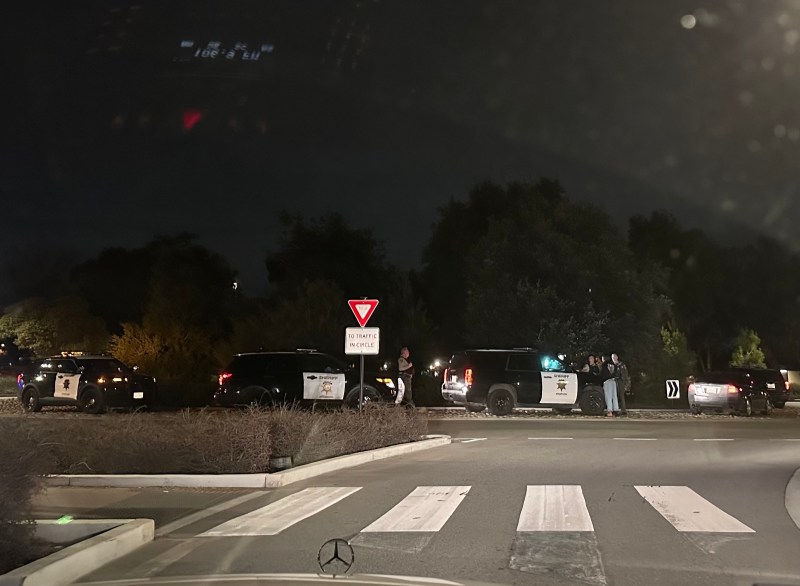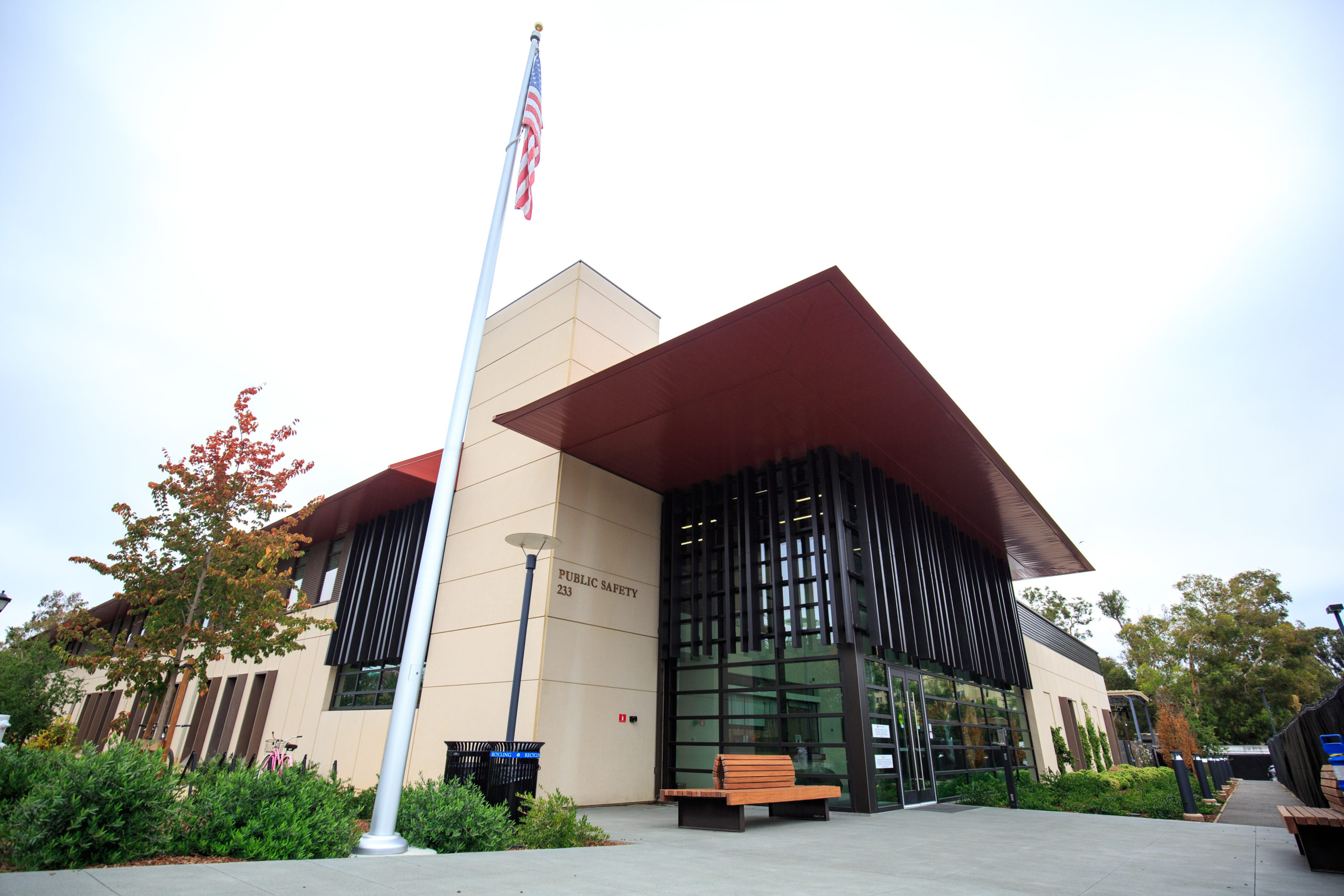This article contains descriptions of policing, anti-Black racism and gun violence.
Jessica Stovall, a fifth-year Ph.D. student, was listening to an audiobook while taking a walk on campus late Saturday night when she said she heard the words “put your hands up” shouted loud enough to “pierce” through her headphones.
She said she followed the sound to a roundabout near the Escondido Village Graduate Residences, where she saw a white Stanford police officer draw his gun on a Black man sitting inside his car.
“I refuse to watch public lynchings. I didn’t watch George Floyd. I will not watch Mr. Nichols. I already carry so much pain that I don’t need to witness and spectate a lynching,” Stovall said, citing a long history of police officers killing unarmed Black men. “What was so painful about this incident was feeling like it was an obligation and my duty to be a witness, should this Black man be turned into the next hashtag.”
Stovall, a student in the Graduate School of Education’s Race, Inequality and Language in Education program, documented her experience on Sunday in a Twitter thread. The post amassed over two million views as of Monday night and the police incident drew widespread condemnation from Stanford affiliates and the broader online community.
Last night, around 11 pm, I was taking a mind clearing walk around Stanford’s campus and witnessed a white police officer draw a gun on a young Black man. 1/11
— Jessica Stovall (@_jessicastovall) January 29, 2023
“My heart goes out to the students who are asked to show up and do their work, to be present, to be smart, even as they’re having to deal with all of that,” said Hakeem Jefferson, an assistant political science professor who studies race and identity.
A Monday post on the Stanford Report confirmed that an incident had taken place Saturday night in which “an officer unholstered his gun and pointed it at a car, driven by a Black individual” and said that the driver had been stopped due to an outstanding arrest warrant for the registered owner of the vehicle, which was not the driver. The post acknowledged that social media “has carried accounts of a police interaction with an individual on the Stanford campus.”
“DPS personnel are keenly aware of the concerns community members have about policing in the United States,” said Department of Public Safety (DPS) Director Laura Wilson in the post. “We understand the level of distrust many persons have about the police, especially persons of color. The recent tragic death of Tyre Nichols at the hands of persons who were police officers emphasizes why distrust is warranted. The actions of those officers do not reflect the values and principles that DPS personnel endeavor to uphold.”
The post said the incident is currently under investigation by the DPS leadership. DPS has also asked the Santa Clara County Sheriff’s Office, which oversees the sworn officers who work at Stanford, to review the incident, according to the post.
University spokesperson Luisa Rapport, who responded to an inquiry originally sent to DPS spokesperson Bill Larson, directed The Daily to the public post. Rapport did not comment on whether the man who was stopped was affiliated with the University.
Saturday night’s incident comes amid high tensions regarding various instances of police brutality across the country. Body camera footage released Friday revealed the brutal beating of 29-year-old Tyre Nichols at the hands of Memphis police.
“As we think about the reporting of this event on campus, we can’t disentangle it from a history and legacy of policing in the country,” Jefferson said. “We can’t think of it as being separate and apart from what happened to Tyre Nichols, another Black man who had an encounter with police in his car.”
Stanford sent a “message of sadness, care, and hope” relating to the Memphis incident on Sunday morning.
Saturday night
The Stanford Report post went into detail regarding the timeline of the incident on Saturday night and the rationale of the officers in their response. Stovall did not directly contest the accuracy of the post. A Daily reporter also observed part of the incident, and their observations matched those made in the post.
According to the post, a Stanford deputy first approached a car stationed in a parking lot of a student residence at 10:47 p.m. on Saturday. The report states that the deputy then had a “brief interaction” with the driver, and noticed “a number of delivery packages in the back seat. The driver explained he was a delivery driver, asked if he was free to leave, and drove away.”
The deputy then decided to run the vehicle’s license plate number, citing “recent concerns about package thefts on campus.” The dispatcher flagged that there was a DUI arrest warrant out for the registered owner of the vehicle, according to the post.

The post noted that four DPS officers, a DPS supervisor and an unknown number of officers from the Palo Alto Police responded to the incident. A Daily reporter observed at least six police cars present at the scene.
The officers ordered the driver to exit the vehicle, and when he didn’t, “another deputy unholstered his gun and pointed it in the direction of the vehicle,” the post states. A second deputy also unholstered his firearm, but it was not pointed at the driver, according to the post.
According to the post, after the gun was drawn, the driver exited the vehicle, was placed in handcuffs and placed in the back of a patrol car. At this point, the officers realized that the driver was not the registered owner of the car, the post said.
Stovall confirmed most of Stanford’s account of the night once the driver was stopped at the roundabout but raised concerns about why such use of force was needed in the incident.
Stovall recalled hearing the driver yelling at the officer, “You can’t arrest me for that.”
Unsure of who to call, Stovall paged a campus emergency line, who was unable to reach the scene on time.
“Who watches the watchman? Who was I supposed to call to get support when there’s police that are harming several people?” Stovall said. “It’s the harm of having a gun pointed at you, the harm of having to witness this happen to someone and how triggering that is.”
The driver was held for around 40 minutes and was let go at around 11:33 p.m., according to Stoval. The post said DPS cited him for possession of marijuana in an unsealed container in the compartment of a moving vehicle.
Stovall tweeted, “before getting back into his own car, the man shouted into the night, ‘And this is the land of the free for a Black man.’”
The Daily has reached out to DPS for comment on Stovall’s account.
Community members cite long history of anti-Blackness in policing
For community members, news of Saturday’s incident brought to the forefront concerns about anti-Blackness in policing and sympathy on behalf of the driver.
“I can’t stop thinking about the man and how he must be feeling and the fact that he had to go through that on a campus that prides itself on being one of the epicenters of knowledge and innovation,” Stovall said.
Jefferson, the political science professor, had left campus just before 9 p.m. that night and felt “grateful” that he did not have to bear witness to this encounter, which is all too common for “so many people who happen to be Black or brown in this country.”
Jefferson noted that racial and class-based stereotypes often heighten suspicions like the ones that reportedly led to officers stopping the driver in the first place.
“It is hard to justify the almost default setting of an escalation that attaches to the holstering of a weapon,” Jefferson said. “Having great knowledge of the history and the way these things manifest, it is often the case that this escalation is at least unwarranted and too close to doing great harm.”
Jefferson also echoed Stovall’s concerns about the driver, adding that he “doesn’t appear to have committed any crime but he leaves this encounter having had guns drawn on him — what I can only imagine is traumatic in its own right — and not understand[ing] why the gun is being drawn or why one is being asked to leave the vehicle,” Jefferson said.
Jefferson noted that police often use suspicion of marijuana use as an excuse to stop and search Black people at a higher rate than white people. Infractions for marijuana are also more likely to be given to Black people than white people in San Francisco, according to a report from The San Francisco Chronicle.
Stovall added that she wishes the University offered services relating to mental health and emotional support for community members who hope to de-escalate situations rather than call the police. Stovall noted that due to the harm and trauma that witnessing this encounter caused, she has had difficulty sleeping and focusing on her academic work.
“Walking is my typical form of stress relief, but I have not wanted to walk ever since I witnessed that,” Stovall said.
She said she hopes that this incident pushes Stanford to review its policies of policing and profiling and make resources available for students who need somebody other than the police.
“The report does not mention all the people who witnessed it, the impact that they had and what they had to walk away from,” Stovall said. “Investing in the care and well-being of people is what I would imagine, instead of a system that only serves to tear and lock away people as if they are not human.”
Jefferson said the University’s decision to investigate the police incident was warranted but that an investigation is a minimum response. He urged the University to critically think about what the standard is for an officer to be allowed to unholster their weapon and develop a concrete articulation of what the standard is for the potential use of force on campus.
Jefferson pointed to a 2021 Stanford report on campus public safety, which recommended reducing policing on campus.
“If we think of Stanford as not being peculiar in the sense of American policing, there’s no reason we should think of policing in this small community as being exceptional when it comes to what we know are the weaknesses of American policing,” Jefferson said.
